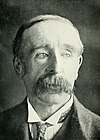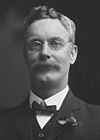
The United Australia Party (UAP) was an Australian political party that was founded in 1931 and dissolved in 1945. The party won four federal elections in that time, usually governing in coalition with the Country Party. It provided two prime ministers: Joseph Lyons (1932–1939) and Robert Menzies (1939–1941).

The Nationalist Party, also known as the National Party, was an Australian political party. It was formed in February 1917 from a merger between the Liberal Party and the National Labor Party, the latter formed by Prime Minister Billy Hughes and his supporters after the 1916 Labor Party split over World War I conscription. The Nationalist Party was established as a 'united' non-Labor opposition that had remained a political trend once the Labor party established itself in federal politics. The party was in government until electoral defeat in 1929. From that time it was the main opposition to the Labor Party until it merged with pro-Joseph Lyons Labor defectors to form the United Australia Party (UAP) in 1931. The party is a direct ancestor of the Liberal Party of Australia, the main centre-right party in Australia.
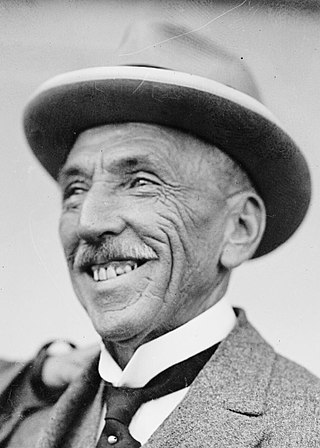
William Morris Hughes was an Australian politician who served as the seventh prime minister of Australia from 1915 to 1923. He led the nation during World War I, and his influence on national politics spanned several decades. He was a member of the federal parliament from the Federation of Australia in 1901 until his death in 1952, and is the only person to have served as a parliamentarian for more than 50 years. He represented six political parties during his career, leading five, outlasting four, and being expelled from three.

The Ministerfor Defence is the minister of state of the Commonwealth of Australia charged with overseeing the organisation, implementation, and formulation of strategic policy in defence and military matters as the head of the Department of Defence. The Minister for Defence is responsible for the Australian Defence Organisation and the Australian Defence Force (ADF). The current Defence minister is Richard Marles, who is also concurrently serving as deputy prime minister of Australia, having been selected by Prime Minister Anthony Albanese in May 2022 following the 2022 Australian federal election.
The National Labor Party was formed by Australian Prime Minister Billy Hughes in 1916, following the 1916 Labor split on the issue of World War I conscription in Australia. Hughes had taken over as leader of the Australian Labor Party and Prime Minister of Australia when anti-conscriptionist Andrew Fisher resigned in 1915. He formed the new party for himself and his followers after he was expelled from the ALP a month after the 1916 plebiscite on conscription in Australia. Hughes held a pro-conscription stance in relation to World War I.

The Second Hughes ministry was the 12th ministry of the Government of Australia. It was led by the country's 7th Prime Minister, Billy Hughes. The Second Hughes ministry succeeded the First Hughes ministry, which dissolved on 14 November 1916 following the split that took place within the governing Labor Party over the issue of conscription. This led to Hughes and his supporters leaving the party to form the National Labor Party, which swiftly received parliamentary support from Joseph Cook and the Liberal Party. The ministry was replaced by the Third Hughes ministry on 17 February 1917 after National Labor and Commonwealth Liberal merged into the Nationalist Party.
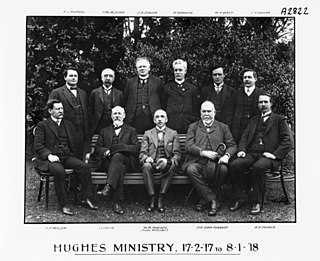
The Third Hughes ministry (Nationalist) was the 13th ministry of the Government of Australia. It was led by the country's 7th Prime Minister, Billy Hughes. The Third Hughes ministry succeeded the Second Hughes ministry, which dissolved on 17 February 1917 after the governing National Labor Party merged with the Liberal Party to form the Nationalist Party. The National Labor Party itself formed as a consequence of the split that took place within the then-governing Labor Party over the issue of conscription. The ministry was replaced by the Fourth Hughes ministry on 8 January 1918 following the resignation of Hughes as prime minister after a vote of no-confidence within the Nationalist Party in the wake of a failed second referendum on conscription. However, due to a lack of alternative leaders, Hughes was immediately re-commissioned as prime minister by Governor-General Sir Ronald Munro Ferguson.

The Fifth Hughes ministry (Nationalist) was the 15th ministry of the Government of Australia. It was led by the country's 7th Prime Minister, Billy Hughes. The Fifth Hughes ministry succeeded the Fourth Hughes ministry, which dissolved on 3 February 1920 following the federal election that took place in December. The ministry was replaced by the First Bruce ministry on 9 February 1923 following the 1922 federal election and the subsequent resignation of Hughes as Prime Minister.

The First Bruce ministry was the 16th ministry of the Government of Australia. It was led by the country's 8th prime minister, Stanley Bruce. The First Bruce ministry succeeded the Fifth Hughes ministry, which dissolved on 9 February 1923 following the December 1922 federal election and the subsequent resignation of Billy Hughes as prime minister. The Nationalists had lost their majority in the election, and had no choice but to negotiate a Coalition deal with the Country Party. However, Country leader Earle Page let it be known that no deal could be made unless Hughes resigned. It is the first ministry that consists of a centre-right Coalition between the senior conservative party and the junior rural party - this Coalition has more or less endured to this day with the modern-day Liberal Party and National Party. The ministry was replaced by the Second Bruce ministry on 18 December 1925 following the 1925 federal election.
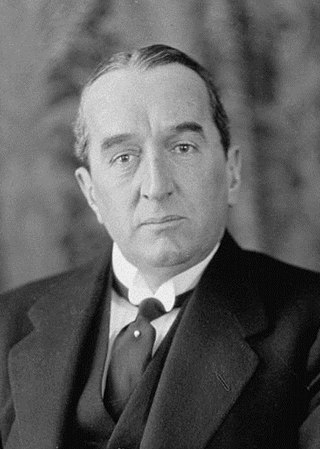
The Second Bruce ministry was the 17th ministry of the Government of Australia. It was led by the country's 8th Prime Minister, Stanley Bruce. The Second Bruce ministry succeeded the First Bruce ministry, which dissolved on 18 December 1925 following the federal election that took place in November. The ministry was replaced by the Third Bruce ministry on 29 November 1928 following the 1928 federal election.

Sir George Foster Pearce KCVO was an Australian politician who served as a Senator for Western Australia from 1901 to 1938. He began his career in the Labor Party but later joined the National Labor Party, the Nationalist Party, and the United Australia Party; he served as a cabinet minister under prime ministers from all four parties.

The Australian Party was a political party founded and led by former Australian prime minister Billy Hughes after his expulsion from the Nationalist Party. The party was formed in 1929, and at its peak had four members of federal parliament. It was merged into the new United Australia Party in 1931, having never contested a federal election.

William Alexander Watt was an Australian politician. He served two terms as Premier of Victoria before entering federal politics in 1914. He then served as a minister in the government of Billy Hughes from 1917 to 1920, including as acting prime minister during World War I, and finally as Speaker of the House of Representatives from 1923 to 1926.

Alexander Poynton OBE was an Australian politician. He held ministerial office under Prime Minister Billy Hughes, serving as Treasurer (1916–1917), Minister for Home and Territories (1920–1921), and Postmaster-General (1921–1923).

William Oliver Archibald was an Australian politician. He was a member of the South Australian House of Assembly from 1893 to 1910, representing Port Adelaide, and a member of the Australian House of Representatives from 1910 to 1919, representing Hindmarsh. Archibald was a Labor member until resigning in the 1916 Labor split; he subsequently served as a Nationalist until his defeat at the 1919 federal election.

Sir Walter Massy-Greene KCMG was an Australian politician and businessman. As a Liberal and Nationalist member of the House of Representatives, he became a protégé of Prime Minister Billy Hughes and was groomed as his successor. He served as Minister for Trade and Customs (1919–1921), Defence (1921–1923), and Health (1921–1923), but his prime ministerial aspirations were brought to an abrupt halt by his defeat at the 1922 federal election. Massy-Greene subsequently served two terms as a Senator for New South Wales, but never regained his earlier influence in politics. In retirement he held numerous company directorships.
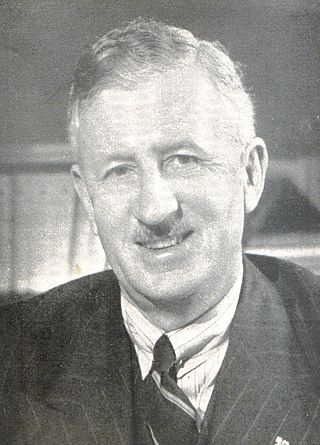
Sir Wilfrid Selwyn "Bill" Kent Hughes, was an Australian army officer and politician who had a long career in both state and federal politics, most notably as a minister in the Menzies government. He also had a longstanding involvement with the Olympic movement, as both an athlete and organiser.

The 1917 Australian federal election was held in Australia on 5 May 1917. All 75 seats in the House of Representatives and 18 of the 36 seats in the Senate were up for election. The incumbent Nationalist Party, led by Prime Minister Billy Hughes, defeated the opposition Labor Party led by Frank Tudor in a landslide.

The Lyons government was the federal executive government of Australia led by Prime Minister Joseph Lyons. It was made up of members of the United Australia Party in the Australian Parliament from January 1932 until the death of Joseph Lyons in 1939. Lyons negotiated a coalition with the Country Party after the 1934 Australian federal election. The Lyons government stewarded Australia's recovery from the Great Depression and established the Australian Broadcasting Corporation.

The Australian Labor Party split of 1916 occurred following severe disagreement within the Australian Labor Party over the issue of proposed World War I conscription in Australia. Labor Prime Minister of Australia Billy Hughes had, by 1916, become an enthusiastic supporter of conscription as a means to boost Australia's contribution to the war effort. On 30 August 1916, he announced plans for a referendum on the issue, and introduced enabling legislation into parliament on 15 September, which passed only with the support of the opposition. Six of Hughes's ministers resigned in protest at the move, and the New South Wales state branch of the Labor Party expelled Hughes. The referendum saw an intense campaign in which Labor figures vehemently advocated on each side of the argument, although the "no" campaign narrowly won on 14 November. In the wake of the referendum defeat, the caucus moved to expel Hughes on 14 November; instead, he and 23 supporters resigned and formed the National Labor Party. Frank Tudor was elected leader of the rump party. Hughes was recommissioned as Prime Minister, heading a minority government supported by the opposition Commonwealth Liberal Party; the two parties then merged as the Nationalist Party of Australia and won the 1917 federal election. The Nationalist Party served as the main conservative party of Australia until 1931, and the split resulted in many early Labor figures ending their careers on the political right. Hughes, for instance, sat as a member of the Nationalists and their successors, the United Australia Party and the Liberal Party, with only a few short breaks until his death in 1952.





